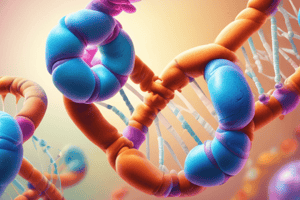Podcast
Questions and Answers
What is the main function of genes in organisms?
What is the main function of genes in organisms?
- Storing genetic information for the next generation
- Directing the production of proteins and RNA molecules (correct)
- Regulating the expression of DNA bases
- Determining the physical appearance of an organism
In DNA, which bases pair together in specific combinations to form nucleotides?
In DNA, which bases pair together in specific combinations to form nucleotides?
- Adenine and Thymine
- Adenine and Guanine
- Cytosine and Thymine
- Cytosine and Guanine (correct)
How does Mendelian genetics differ from other genetic studies?
How does Mendelian genetics differ from other genetic studies?
- It primarily studies mutations in DNA structure
- It focuses on environmental factors impacting genetics
- It involves the study of single gene traits inheritance (correct)
- It deals with multiple gene inheritance patterns
Which scientist is often referred to as the father of Genetics?
Which scientist is often referred to as the father of Genetics?
How do genes ensure continuity across generations?
How do genes ensure continuity across generations?
What happens if both parents have the recessive allele?
What happens if both parents have the recessive allele?
How do epigenetic changes affect gene expression?
How do epigenetic changes affect gene expression?
In what scenario could an offspring inherit the recessive allele?
In what scenario could an offspring inherit the recessive allele?
How do environmental factors impact gene expression?
How do environmental factors impact gene expression?
What insights can genetics provide according to the text?
What insights can genetics provide according to the text?
Study Notes
Genetics: Understanding the Basics of Our DNA
Genetics is the scientific study of heredity and variation in organisms. It examines how traits are passed down from parents to offspring and how these traits can change over time. Understanding genetics helps us understand why certain characteristics are more common among some individuals or families than others. Here's a closer look at the basics of genetics:
DNA Structure and Function
The building block of genes is called deoxyribonucleic acid (DNA). DNA consists of two strands coiled together like a ladder with rungs made up of four chemical bases - adenine (A), cytosine (C), guanine (G), and thymine (T). These bases pair together in specific combinations, forming what we call nucleotides (A-T and C-G pairs). This base pairing allows the information stored within our DNA to be read by cells and used to create proteins necessary for life processes.
Genes and Inheritance
Genes are segments of DNA responsible for coding instructions to make functional RNA molecules or proteins. They carry the genetic information from one generation to the next, ensuring continuity across generations. A gene from each parent gets combined during fertilization to form the child's unique set of genes, which determines their trait inheritance patterns.
Mendelian Genetics and Traits
Mendelian genetics, named after Gregor Mendel who first studied it, deals with single gene traits where an individual inherits one allele from each parent. Each trait has a dominant and recessive allele. If both parents have the dominant allele, the offspring will express the dominant trait; if both parents have the recessive allele, the offspring will also express this trait. However, when one parent has the dominant allele while the other carries the recessive variant, there is a chance that the offspring could inherit the recessive allele.
Environmental Impact on Gene Expression
While genes determine our basic blueprint, environmental factors play a significant role in determining which genes get expressed and how they interact with each other. For example, epigenetic changes can occur due to external stimuli such as stressors or nutrient availability, leading to modifications in gene expression without altering the underlying DNA sequence.
In conclusion, genetics is a fascinating field of biology that provides insights into the fundamental units of heredity and how they influence our traits and susceptibility to certain diseases. By understanding the basics of DNA structure, gene function, inheritance patterns, and environmental impacts on gene expression, we can begin to appreciate the complex interplay between genetics and health outcomes.
Studying That Suits You
Use AI to generate personalized quizzes and flashcards to suit your learning preferences.
Description
Explore the fundamentals of genetics, including the structure and function of DNA, the role of genes in inheritance, Mendelian genetics and traits, and the impact of the environment on gene expression. Gain insights into how genetic information is passed down from parents to offspring and how it influences our traits and susceptibility to diseases.




